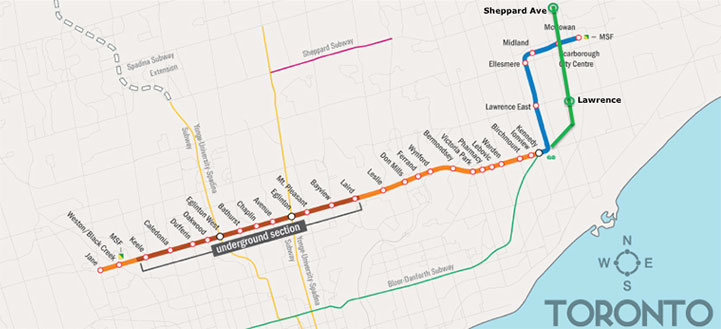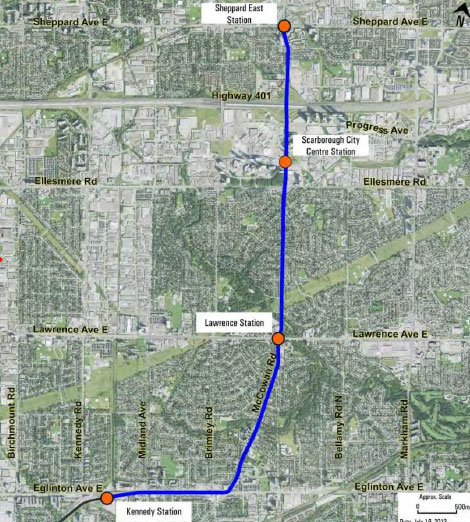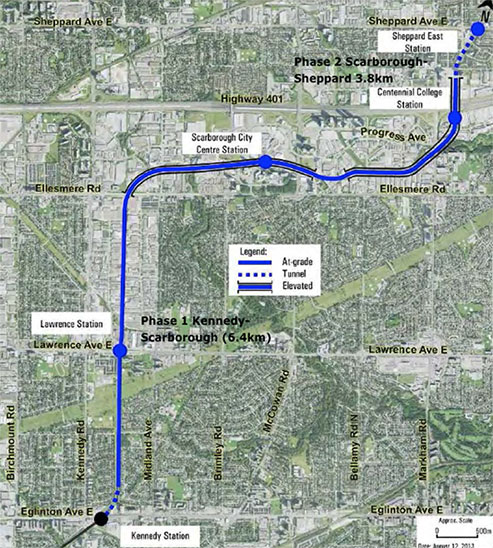Toronto advances 7.6km subway extension 28 Jan 2015
The aging Scarborough Rapid Transit (SRT) system in Toronto, Canada, is being redesigned as a $3.1 billion all-underground 7.5km subway extension of the existing Bloor-Danforth Line. Hatch Mott MacDonald (HMM) is engaged by the Toronto Transit Commission (TTC) for preliminary tunnel design while “detailed assessment of all potential subway routing options” is considered.
Work has already started by UBS on an Environmental Assessment, and although a precise alignment is not yet finalized, one option that has garnered a significant amount of local support is for an all-underground route that extends the existing subway east out of Kennedy Station.
From here the extension would veer north under McGowan Road to new underground stations at Lawrence and Scarborough City Centre, before terminating at a new Sheppard Avenue station (Fig 1). This will likely connect with the future planned, and funded, eastward extension of the Sheppard Line.
Engagement of HMM at a cost of $30 million appears to mark a final victory for supporters of the more expensive all-underground solution to the long-running problem of how to replace the 30-year-old SRT system. The existing set operates separately from the Bloor-Danforth subway and requires travelers to change trains at Kennedy Station. It is also more than 30 years old, and operates with rolling stock that has almost reached the end of its serviceable life.
“The corridor we will be looking at will run underground for the entirety of its 7.5km length,” said Tomas Gregor, HMM Senior VP for Underground Infrastructure. “The possible excavation method, number of TBMs that would be needed if mechanized tunneling is selected, and the diameter of the tunnels are all still open.”
The SRT replacement was originally designed as a 4-station 10.2km grade-separated light rail surface route. Initially, only the first 6.4km as far as Scarborough City centre (Fig 2) was to be progressed, and only short sections at the very beginning and the very end of the alignment were designed to run underground, with most of the Phase 2 construction being elevated. Agreement and funding for this solution was reached in 2010 by Metrolinx, the City of Toronto and the Ontario Provincial Government, as part of an inter-agency/government Master Agreement (MA) on an $8.4 billion package of LRT and subway programs across the city. The other programs covered by the MA include the new 19km Eglinton (Crosstown) Line (currently under construction, and also terminating at Kennedy Station – the orange section in Fig 3), the Finch West extension, and the Sheppard Line East extension.
The Provincial Government had already agreed to fund the $1.48 billion needed (at 2010 prices) to construct the surface level alignment as far as Scarborough, and an Environment Assessment had been completed.
In 2013, however, the City broke ranks with the Province and expressed a preference for a subway extension that would instead run the existing Bloor-Danforth Line all the way to Sheppard Avenue in one go, via Scarborough (Fig 2).

Toronto LRT and subway system. Surface-level replacement of the existing SRT (blue) scrapped in favour of an underground extension to the Bloor-Danforth subway line (green)
It was argued that a surface level alignment would cost more to maintain as a result of exposure to Toronto’s harsh winters. There was also concern that a gradient of 3% in open cut sections would pose problems in ice and snow conditions. Additionally it would have been necessary to close the existing SRT during the four-year construction phase of the light rail replacement, which broadly follows the same route. In a tight vote (24-20) the City voted to accept the recommendation of its transit agency, the Toronto Transit Commission (TTC), and seek to amend the Master Agreement between the transportation partners.
After a political battle the Province agreed to maintain its funding at £1.48 billion for an alternative subway extension option, but only on condition that the City cover already-incurred costs on the scrapped project, estimated at more than $100 million.
Responsibility for developing the project through preliminary design and alignment, for developing a brand new EA Report, and for overseeing contract awards and construction management is passed from Metrolinx (the Province) to TTC (the City).
The Federal Government, meanwhile, has pledged extra funding of $660 million to any revised Scarborough subway extension, but the City is having to pick up a $1 billion shortfall in the revised estimated total cost of $3.1 billion – by way of a 1.6% increase in property taxes over the next 30 years.
"Although there is support for the alignment via McCowan Road, it is also recognised that the preferred alignment must be determined through detailed assessment of all potential subway routing options in this area: that study is currently underway,” said Tim Laspa, Transportation and Planning Director at the City Planning Division.
He added: “The project assessment involves planning and preliminary engineering work that will examine nine corridor options. The assessment will proceed in three phases: setting the scene (the current stage of work), choosing the corridor and recommending the alignment. Once determined the preferred route and station locations will be subject to a final review through the Transit Project Assessment Process (TRAP) to satisfy Ontario’s Environmental Assessment Act. We will be identifying the preferred corridor at the end of our Phase 2 work, and selecting a preferred alignment in Phase 3.”
The outline schedule envisages final alignment selection by the end of this year (2015), completion of the revised EA process by Spring 2016, and a five-year construction program beginning in 2018 for services to start in 2023.
References
- Toronto awards Crosstown LRT eastern section – TunnelTalk, November 2013
- Extra tunnels for Toronto Crosstown LRT – TunnelTalk, January 2013
- First tunnel award for Crosstown LRT – TunnelTalk, September 2012
- Toronto axes 17km of tunnels – TunnelTalk, May 2012
- Tunneling to commence on Toronto Spadina Subway Extension – TunnelTalk, May 2011
- Spadina extension awarded in Canada – TunnelTalk, November 2010
|
|
|
|
|
Add your comment
- Thank you for taking the time to share your thoughts and comments. You share in the wider tunnelling community, so please keep your comments smart and civil. Don't attack other readers personally, and keep your language professional.




